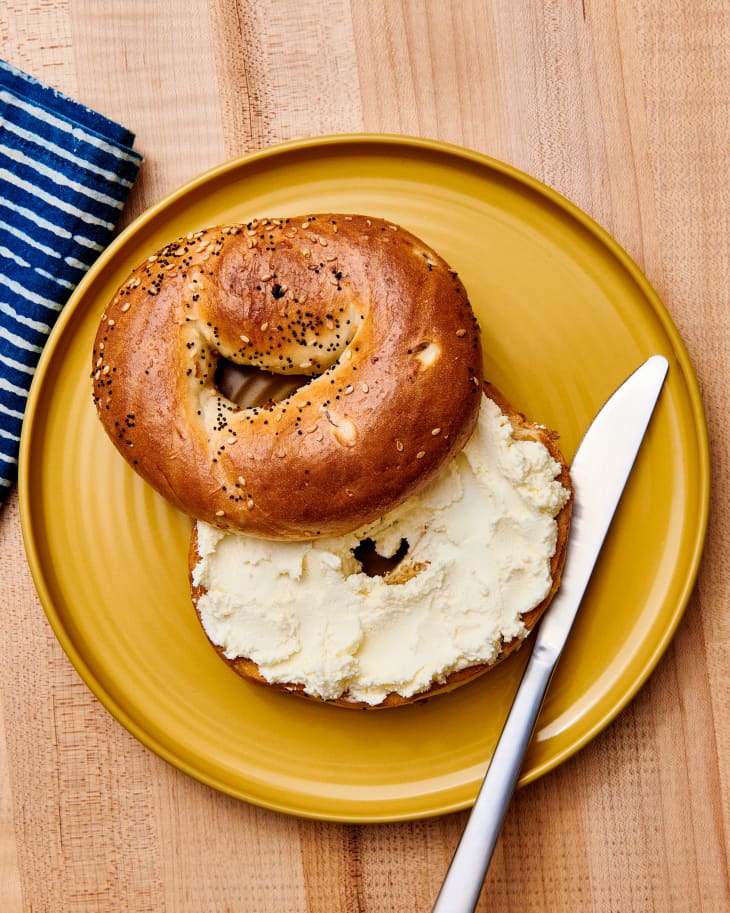How To Make Cream Cheese

Here is a step-by-step recipe for 4-ingredient homemade cream cheese.
Serves8
Makesabout 1 cup
Prep10 minutes
Cook7 minutes
What do bagels, carrot cake, and cheesecake all have in common? Cream cheese! That rich, creamy, fresh cheese is the backbone of recipes enjoyed morning, noon, and night. Would you believe me if I told you that you can make cream cheese at home? It’s true and it only takes four ingredients and a bit of time — much of it hands-off!
If you are looking for an easy introduction to at-home cheesemaking, need a rainy-day activity, or are eager to avoid any future cream cheese shortages, then this recipe is for you. Here is a step-by-step recipe for four-ingredient homemade cream cheese.
How Is Cream Cheese Made?
Making cream cheese at home is a four-stage project.
- Heat whole milk and heavy cream. Slowly bring the milk and cream to a simmer to encourage the milk proteins to unravel.
- Coagulate milk protein with an acid. Stir in distilled white vinegar and allow the dairy to separate into curds and whey.
- Separate curds from whey. Slowly pour the dairy through finely woven cheesecloth and set aside at room temperature until no more whey drips through. Tie the cheesecloth into a bundle and suspend it over a bowl in the refrigerator to extract more whey and firm the cheese.
- Season the cream cheese. Use a spatula to work in kosher salt and any other flavorings into the cream cheese.
Can You Make Cream Cheese with Any Dairy Product?
No. Avoid ultra-pasteurized or ultra-high temperature pasteurized (UHT) milk, as this process alters the protein structure and prevents curds from forming. Pasteurized milk is okay. Most organic milk on grocery store shelves is ultra-pasteurized, so make sure to check the label carefully. Heavy cream can be ultra-pasteurized (and it’s actually difficult to find a carton that is not ultra-pasteurized), as it is included in the ingredient list for its fat content. Cream cheese requires a certain amount of fat for its classically creamy consistency, so it’s best to use whole milk and heavy cream, as opposed to a lower-fat version (say, 2% milk), in this recipe.
What Equipment Do You Need to Make Cream Cheese?
Cream cheese is a great introduction to cheesemaking because you should already have most of the equipment in your kitchen. You will need the following items:
- Measuring cups and spoons
- Medium stainless steel saucepan
- Instant-read thermometer
- Rubber spatula
- Finely-woven cheesecloth* or butter muslin
- Fine-mesh strainer
- Large bowl
- Kitchen twine
*A note about cheesecloth. Avoid the loosely woven cheesecloth sold at grocery stores, as this will not let the proper amount of whey drain, even when multiple layers of the cloth are used. Purchase finely woven (often reusable!) cheesecloth, like this one; or butter muslin, a style of fine cheesecloth specifically designed for cheesemaking, instead.
Does Homemade Cream Cheese Taste Like Store-Bought?
Because vinegar is used to develop the curds in homemade cream cheese (rather than a microbial starter or rennet, as is often the case with store-bought), this homemade cream cheese has a pleasantly sour, tangy finish. The texture is thick and rich, but does not have the bouncy texture that commercial cream cheese may have from the added gums and stabilizers.
How to Make Cream Cheese Recipe
Here is a step-by-step recipe for 4-ingredient homemade cream cheese.
Prep time 10 minutes
Cook time 7 minutes
Makes about 1 cup
Serves 8
Nutritional Info
Ingredients
- 2 cups
whole milk (not ultra-pasteurized)
- 1/2 cup
heavy cream
- 3 tablespoons
distilled white vinegar
- 1/4 teaspoon
kosher salt, plus more as needed
Equipment
Measuring cups and spoons
Small saucepan
Instant-read thermometer
Rubber spatula
Fine-mesh strainer
Large and small bowls
Kitchen twine
Instructions
Heat the dairy. Place 2 cups whole milk and 1/2 cup heavy cream in a small stainless steel saucepan over medium heat until tiny bubbles form around the edge of the pan, a translucent film develops over the surface of the milk, and an instant-read thermometer registers 190°F, about 8 minutes.
Add the vinegar. Remove the saucepan from the heat. Add 3 tablespoons distilled white vinegar and stir to combine. Let sit at room temperature for 1 hour to let the small curds separate from the thinner whey.
Prepare for straining. Meanwhile, run an 18x18-inch piece of finely-woven cheesecloth or butter muslin under water, then squeeze out the excess moisture. Lay the cheesecloth in a single layer in a fine-mesh strainer and fit over a large bowl.
Strain the curds. Gently pour the curds and whey into the cheesecloth. Let drain at room temperature until no more whey drips into the bowl (the bottom of the strainer should not touch the liquid in the bowl), about 20 minutes. Discard the whey or reserve it for another use.
Drain in the refrigerator. Gather up the sides of the cheesecloth into a bundle, twist the bundle a few times, and tie closed with kitchen twine. Suspend over the now-empty bowl so that the bundle does not touch the bottom of the bowl (one way is to tie the bundle onto a chopstick and lay the chopstick across the top of the bowl). Refrigerate until no more whey drips and the cheese is your desired consistency, 1 1/2 to 2 hours.
Season the cream cheese. Transfer the cream cheese to a small bowl. Add 1/4 teaspoon kosher salt and stir to combine. Taste and season with more kosher as needed.
Recipe Notes
Storage: Transfer to an airtight container and refrigerate for up to 7 days.
